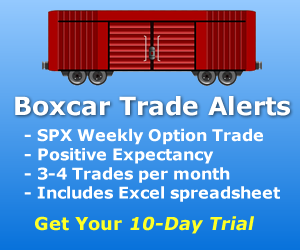SPX and SPY are two very similar instruments from which a trader can choose. Today we will talk a bit about the similarities and differences between the two.
What is SPX?
SPX is the nickname for the Standard and Poor's 500 Index. It is based on the 500 largest companies whose stock trades on the NYSE or NASDAQ. A list of the 500 companies currently within the SPX can be found here: List of S&P 500 Companies from Wikipedia.
The SPX is a capitalization-weighted index, unlike the Dow Jones Industrial Average which is an index consisting of an equal amount of shares of each of the 30 companies in the DJIA. To further explain capitalization-weighted index; the weight of a company in the index is equal to the market cap of that company, divided by the total market of all the companies in the index. As defined by Investopedia, “Market capitalization refers the total dollar market value of a company's outstanding shares. Commonly referred to as “market cap,” it is calculated by multiplying a company's shares outstanding by the current market price of one share.”
The underlying asset itself does not trade, so there are no shares to be purchased or sold – only options. Because the market capitalization of the majority of stocks changes from day to day, the list of the 500 specific companies in the S&P 500 is updated from time to time.
What is SPY?
SPY, also called “Spyders”, is an exchange traded fund (ETF). When an investor is buying or selling SPY, the price is very close to 1/10th of the price of SPX. What is an ETF? Exchange traded funds are explained in an article published here on Capital Discussions on February 11, 2017. The article can be found here: A Little About ETFs.
Basically, Exchange Traded Funds (ETFs) are funds that track indexes such as the S&P 500, NASDAQ, Dow Jones, Russell 2000, etc. When an investor buys shares of an ETF, they are buying shares of a portfolio that tracks the yield and return of the related index. ETFs have been around since the early 1980s, but have become more popular to investors over the past ten years. Shares of SPY can be purchased and sold, as well as options.
What are some of the differences between SPX and SPY options?
- SPY options are American style and may be exercised at any time before they expire. SPX options can be exercised only at expiration.
- SPY pays a dividend, and SPX does not. Dividends are paid quarterly, usually at options expiration in March, June, September, and December.
- SPY options are settled in shares. SPX options are settled in cash.
- SPY options stop trading at the close on expiration day. SPX options are a little bit more complicated. With the exception on SPX options that expire on the third Friday of the month, SPX options expire at the close on expiration day. SPX options that expire on the 3rd Friday of the month stop trading the day before expiration Friday. The actual settlement price, however, (the closing price for the expiration cycle) is determined Friday's opening prices of each of the 500 stocks in the S&P 500 index. So any positions in SPX that are not closed the day before expiration on the 3rd Friday are subject to overnight risk until the settlement Friday morning.
- There are different tax treatments between SPX and SPY. SPX is a Section 1256 contract. In the USA, Section 1256 contracts allow a trader to treat 60% of the gains at the long term capital gains rate. This long term rate has a more favorable tax implication. The remaining 40% of profits is treated at a less favorable short-term rate. SPY does not qualify for Section 1256. Of course, you should consult with your tax advisor to determine how these tax implications may or may not have a significant impact on your own financial situation.
In summary, there are many choices of instruments available to traders today….individual stocks, exchange traded funds, and index funds. This overview of SPX and SPY, and the differences between the two, is meant to provide a little more information on these two popular trading instruments. Like every element in trading, there are pros and cons of each – the choice is yours.
If you would like to see how successful traders make their decisions on which underlying to trade, join one of the trading groups offered at Capital Discussions. Perhaps you can pick up a tip to improve your decision-making process.


